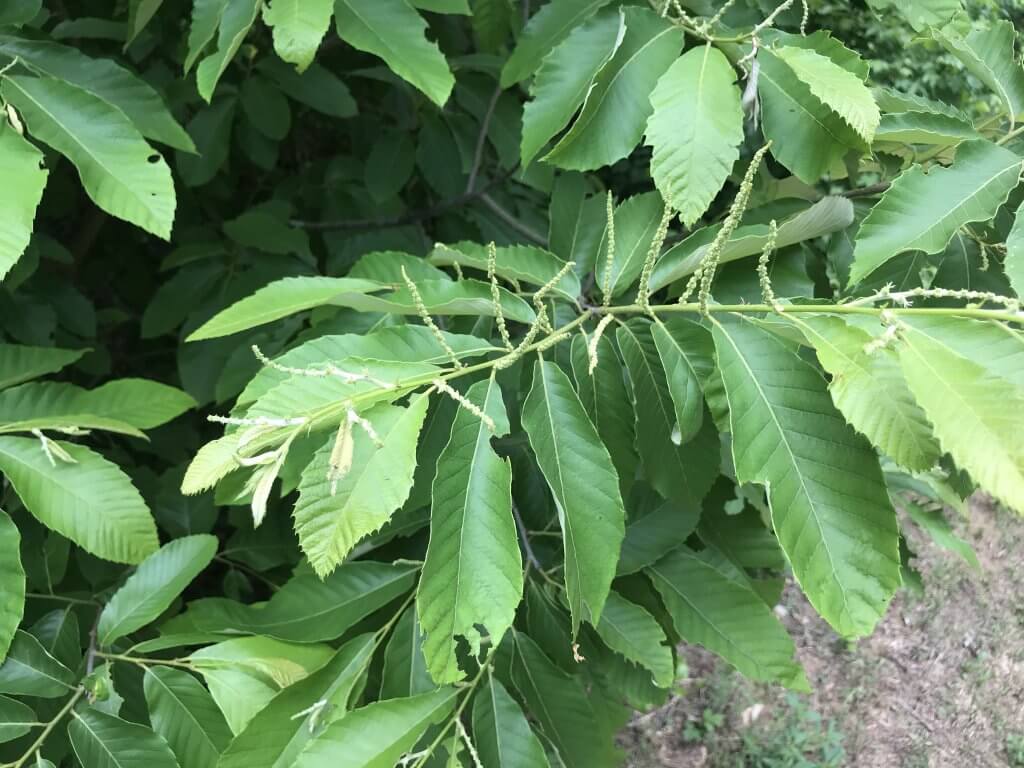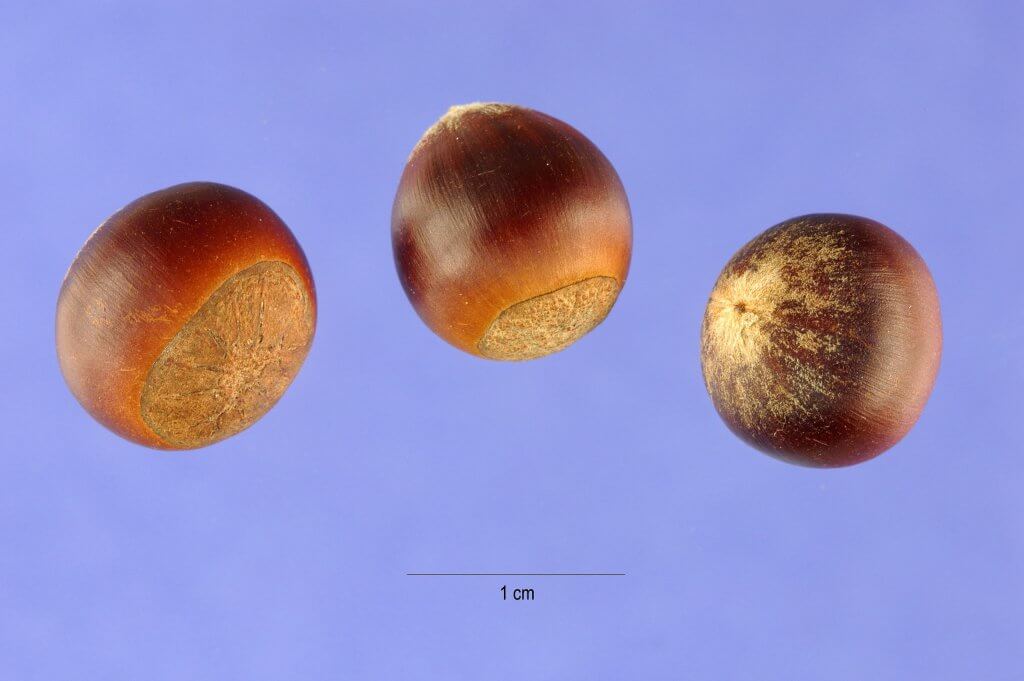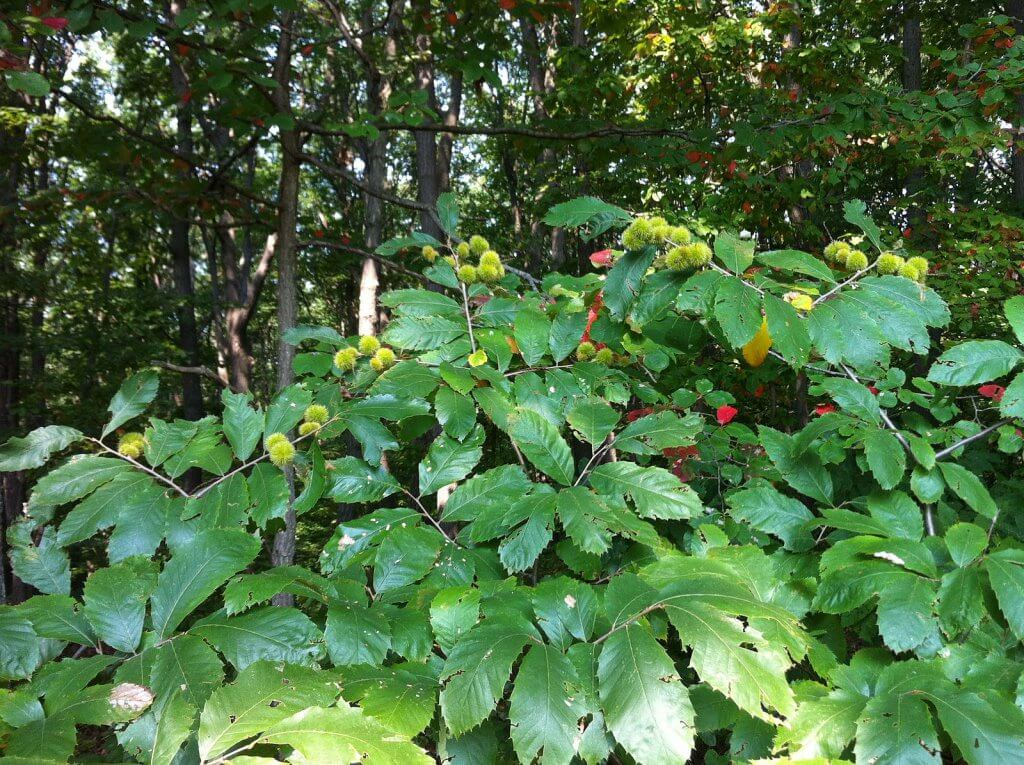Chinquapin (Castanea pumila) is a species of tree native to midwest and southeastern states, particularly North and South Carolina and also Georgia. You may also know it by the names, dwarf chestnut, allegheny chinquapin or simply American chinquapin. As its other name suggests, chinquapin is a species of chestnut, bearing small nuts that are rounder in shape.
You’ll tend to find it growing on high ground, with particularly sandy, very well draining soils. You’ll also often find it growing in the company of pecan trees and also oak.

The chinquapin is a small tree, reaching only a third of the height (10m) of its Northern relative the American chesnut (Castanea dentata). The leaves are simple, serrated, lance shapes, no longer than 15cm. When it flowers in spring, small catkin like stalks emerge from the leaf joints. Both female and male flowers can be found on the tree. The fruits which form after flowering are small spiny spheres, which develop the shiny brown chinquapin nut within.
Edible parts and other uses
The nut is the only edible part of the chinquapin tree, as the leaves and bark contain toxic tannins. The nut can be roasted much like the chestnut, and eaten whole as a snack. Roasting enhances the slightly chocolatey flavoring of the nut. To enhance the sweetness of the nut, it is often recommended to hang the nuts in a porous bag, to allow them to dry and for the starches to break down into sugars.
Native Americans recognised the importance of chinquapin nuts, incorporating them into their seasonal food diet.
The wood is very durable, and is often utilised for creating wood products and even fencing. However due to its small size, other hardwoods tend to be more favorable.

Cautions
The nuts of the chinquapin are perfectly safe to consume. However like many foods, they should be eaten in moderation. The only lookalikes for the chinquapin, are the sweet chestnut and horse chestnut trees, both having spiny burrs. The chestnut is also perfectly edible, however, the horse chestnut (Aesculus hippocastanum) is toxic. They can usually be identified by the shape and color of the nut, and also the lower number of spines on the burrs of horse chestnut.
Foraging
The tree reaches fruiting maturity at around 4 years old, so don’t be surprised if you encounter a few young trees which don’t seem to hold any fruits.
The chinquapin fruits begin to ripen in the fall, splitting open to reveal the nut within. Small mammals and birds are also particularly fond of the nuts, so you will need to time your foraging adventure correctly to get the best yield! Any nuts out of reach can sometimes be prompted with a small shake of the tree. However the chinquapin tree is sadly on the endangered species list, so foraging must be enacted very responsibly.

Did you know…
Chinquapins can also be found on the west coast, from southern California, up to Washington. Inhabiting similar mountainous slopes two species of chinquapins from a different genus can be found here, the golden chinquapin (Chrysolepis chrysophylla) and also the bush chinquapin (Chrysolepis sempervirens).
Conclusion
A tree that has somewhat faded into history, but is slowly re-emerging onto the radar as a nutritious wild food. For those wishing to have a supply of nuts closer to home, a chinquapin is a great option to grow at home in a smaller garden due to its smaller size. Their small population numbers were caused by the spread of chestnut blight, killing off a great number of American chestnuts, as well as denting the dwarf chestnut population. This means that foraging must be kept to a minimum, to ensure population sizes can replenish and grow.
—————Written by Hannah Sweet
Hannah is a freelance writer and graphic designer from the UK. With a penchant for travelling, photography and all things botanical, she enjoys writing about a wealth of topics and issues, from conservation and slow living, to design and travel. Learn more about her writing and design services at www.sweetmeanders.co
Many of our readers find that subscribing to Eat The Planet is the best way to make sure they don't miss any of our valuable information about wild edibles.
See our privacy policy for more information about ads on this site







7 Responses
Can chinquapins be toxic to some people? My chinquapin shrubs produced plenty of nuts this year and I have been eating them but recently have had vomiting 2-3 hours after eating about 10-12 nuts. Could the chinquapins be causing this? I DO know that these are chinquapins and not something else. I’m 77 years old but used to eat chinquapins a lot when I was a kid.
That’s Scary, I used to eat them to as a Kid, from Texas, but my body is different now that I’m 80 years maybe I can’t have them now, so I want order them.
Do you grow the trees, I’m from Texas and we would find them growing in the wild we would pick them right from the tree? I put my website on here it is a Healthy Natural Product, You can join as a Affiliate and be able to get products @ Wholesale Price very good products.
Hi Verdie, We just received 5 of the chinquapin trees free from the county extension office.My husband remembers eating them as a kid at his grandmother’s place. We planted chinquapin oaks years ago, but realized later that was not the correct tree.We live in Mt. Pleasant which is on the border of the range they grow in.Where did you find them when you were a kid? We are giving two to our daughter who lives in Nacogdoches. I think she may have more success than we will, especially since that is where my husband’s grandmother lived.
I bought 3 chinquapin shrubs in Knoxville, TN. Two years ago I ate them with no problems but last year and this year, they have caused an upset stomach. It’s probably that something has changed with my body–I’m 77 years old. As a kid in Southwest Virginia, we found them growing along the road we walked to get to the school bus. This year’s crop is large and I so wish I could eat them. The squirrels are enjoying them instead.
I do grow the chinquapin shrubs in my backyard in Knoxville, TN. I have tried the chinquapins again this year and they again caused a very upset stomach. No more chinquapins for me.
would love to be able to purchase some of the nuts but cant find any